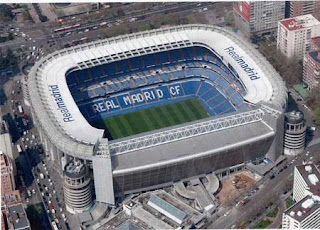In 1998, the Club adopted a master plan for the stadium infrastructure, to modernize and make more comfortable all its structures. At the time, was set in motion an ambitious commercial project to become a Bernabéu open 365 days a year. The centennial will be used to celebrate a stadium that was growing and walked steadily toward his dream of being elite.
The modernization process that took place at the Club during the 1999-2000 season was known as "Project Leader XXI" With regard to the stadium, took out a waymarks of Santiago Bernabeu, which sectorizes all the same.
With the renovation of third amphitheater (Padre Damián street), placed 9,380-seater,which completed the previous season's performances, which had installed new 16,000-seat distributed in different areas. Thus, capacity was definitely reduced to 75,000locations
Infrastructure plan for stadium
In July 2000, Florentino Perez became president of Real Madrid. Following the provisions of the Master Plan Infrastructure Stadium, which included both the technical upgrading of all facilities and infrastructure such as launch of new lines of business within an ambitious commercial facilities.
The "offices" of the players are changing, their second home. Suffered an extraordinarycomprehensive reform, the end result brought unanimous praise. The news followed. Scoreboards were changed. Another major release of the field was a new public address system. If the stadium grew, their supplies should do. This will set the ring of facilities, basic provisions, electricity, water supply and sanitation.
Best stadium heated in the world
The Santiago Bernabeu was not a pioneer in introducing a heating system. The Nuevo Zorrilla (Valladolid) was the first in Spain to use heat, but its 58 radiators were a great distance from the 1,300 installed at the Bernabeu, which would make it the enclosure with the largest heated surface of the world.
Operating trends
At the start of the 2002-03 season, the dream would become a "stadium 365 days a year " as was the case in many countries, where the compounds were transformed into real weekdays businesses. Without doubt, one of the major developments of the campaign was the launch of "Stadium Tour", an exciting adventure where visitors had the opportunity to discover all the secrets of the stadium. Panoramic elevators, VIP areas, press room, marquee players, locker room, dugout, pitch, presidential box and exhibition of trophies, made up the exciting journey of a service over the years, become a major source Club income.
Cover of Padre Damián: The Stadium closes
In the 2003-04 season, also finished work on the new east side housing, certainly the largest project had undertaken in recent years. A cover that was not only close. It was at the same time, giant screen and diffusing light.
 |
| Santiago Bernabéu Stadium |
If the deck was amazing, even more so was the result of the new facade of the east side, spectacular. The materials used were galvanized metal sheets, rolled and translucent, permeable to wind and light. Projections could be made from the outside (to see the name of the Club, the brand ...) and from the inside: when the galleries are on, would be perceived movement.
Restaurants
The first restaurant in the history of the Santiago Bernabeu was inaugurated on December 17, 2004. With direct access through the Padre Damián street (Stadium gate 57), stood out for having a magnificent view of the interior and the pitch from the main dining room. Second restaurant was opened on July 1, 2005. Had direct access from the outside, in this case from the Concha Espina avenue (gate 30) It has a facade to the interior and on the field, more than 50 meters.
No comments:
Post a Comment